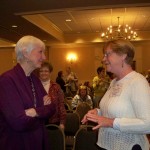This week is Young Adult Library Services Association’s Teen Tech Week (March 5 – 11, 2017). Just as Digital Learning Day is a snapshot of what should be happening in school libraries every day so are the learning activities that are being spotlighted this week.
 One thing that continually surprises me is that some people, new and practicing school librarians included, think that engaging students and supporting classroom teachers with Web-based resources and technology-infused learning experiences is something new in our profession. It’s not!
One thing that continually surprises me is that some people, new and practicing school librarians included, think that engaging students and supporting classroom teachers with Web-based resources and technology-infused learning experiences is something new in our profession. It’s not!
Ever since the Internet entered schools, effective school librarians and progressive school libraries have been at the center of providing digital resources and services (in addition to reading instruction and literature-focused events and activities).
New technology tools were a central feature in the school libraries where I served in the 1990s. Like many school librarian colleagues, I wrote grants to fund increasing technology tool access through the school library program. Also, similar to many colleagues, I convinced my principals that the central location of the library as the hub of learning in our schools was the appropriate place to provide equal access to all students, classroom teachers, specialists, and families.
In 1992, our elementary school library was the first in the district to have a stand-alone and dedicated CD-ROM computer station. In 1994, I secured grant funding at another elementary school library in another district in order to provide the most “sophisticated” access to CD-ROM reference resources using a then “cutting-edge” server tower. In the summer of 1994, I facilitated a two-week summer technology camp for first through fifth-grade students to utilize the new software (HyperStudio) we had purchased for the library with grant funds. Fourth-, and fifth-grade students mentored first-, second-, and third-grade students and co-created exciting multimedia projects that would serve as samples for classroom teachers and other students during the following school year.
In 1995, our school library facilitated the first student-designed elementary school website in Arizona. In 2000, when I served at another Tucson Unified School District elementary school, our school library website earned an Arizona Technology in Education Award (AzTEA) for the Best School Website; at that time, ours was the only site in the entire state designed, created, and managed by students.
While I took a leadership role in all of these technology-centered initiatives, I most certainly did not do them alone.
Business partners provided grant funding for soft- and hardware. The computer lab teacher I worked with in 1994 taught me most of what he knew about educational technology. He helped me select HyperStudio and an adaptor that transferred the computer screen to the TV screen; these tools literally transformed students’ learning and students’ and educators’ presentations. In 1995, a master’s in library science student intern taught me how to use website software and a bit about .html code; together we facilitated third-grade students’ design of our school’s site. Building on that experience in 1998 at a different elementary school, I formed a website advisory committee comprised of fourth-grade students, classroom teachers, a parent, and our principal and together we planned our school library website. Our goal was to put students in charge of the site. In 2000, we earned the AzTEA award mentioned above.
All of these experiences taught me that collaboration and co-learning are essential in effectively integrating new technology tools into teaching and learning. Learning from and working with more proficient peers gave me the skills I needed and the confidence to take risks. I believe my own willingness to experiment helped classroom teacher colleagues stretch themselves and take risks alongside me. Being an adult learner myself, I was sensitive to their needs and characteristics as adult learners.
Even more than the particular tool or project, it was my role as an instructional partner that helped us effectively integrate technology tools and instructional strategies into our shared curriculum. It was through coplanning and coteaching that I was able to serve as a change agent and helped diffuse technology and other innovations throughout our learning community.
Technology stewardship has long been a responsibility of school librarians, and through classroom-library collaboration school librarians are positioned to serve as technology stewards who facilitate learning with technology in a future ready learning environment.
Image created using Microsoft PowerPoint




